My next speaker project is embryonic at this stage but I'm starting to think about what I'd like to try. It will certainly be a pair of active multi-way floor standers for hifi stereo music; as a rough indication, around 85dB with 15dB peaks at a couple of meters would likely suffice. As part of it, I would particularly like to include a small upper-midrange driver (say about 3") from roughly 800hz upwards.
Some years back I'd unquestionably have crossed that to a tweeter. However.. I'm now old enough to not hear beyond about 12khz (and likely that will drop more over time). I don't need to listen off-axis beyond what would cover one listening chair (or a two-seater, at most) at a few meters. So I'm strongly tempted to use one of the small wide-range (or full-range) drivers for everything above 800hz or so. It would be a compromise, but not sure how much of one. The alternative, crossing to a HF tweeter isn't completely free of compromise either, and in this case it would involve an extra active way.
Some of these little wide-ranges do seem quite potential for that use. By way of example some measurements that Zaph made in Aug 2010 on one of the flavours of scanspeak 10F (the 4424G00) though of course there are alternatives (I just showed this one due to finding decent measurements of it).
0-15-30-45-60 degree FR:
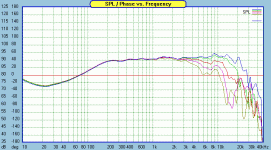
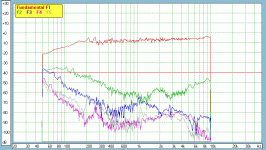
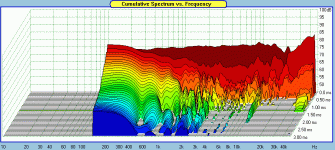
On paper, possibly quite a reasonable choice for my needs. Just wondered what other people think of the idea?
Thanks,
Kev
[BTW I do realise one can use a Full-Range crossed lower, or even not at all. But the use-case of interest to me here in this thread is only as the top end in a multi-way (with 10" and probably ~6.5" drivers for the lower frequencies), hence posting in the multi-way forum].
Some years back I'd unquestionably have crossed that to a tweeter. However.. I'm now old enough to not hear beyond about 12khz (and likely that will drop more over time). I don't need to listen off-axis beyond what would cover one listening chair (or a two-seater, at most) at a few meters. So I'm strongly tempted to use one of the small wide-range (or full-range) drivers for everything above 800hz or so. It would be a compromise, but not sure how much of one. The alternative, crossing to a HF tweeter isn't completely free of compromise either, and in this case it would involve an extra active way.
Some of these little wide-ranges do seem quite potential for that use. By way of example some measurements that Zaph made in Aug 2010 on one of the flavours of scanspeak 10F (the 4424G00) though of course there are alternatives (I just showed this one due to finding decent measurements of it).
0-15-30-45-60 degree FR:



On paper, possibly quite a reasonable choice for my needs. Just wondered what other people think of the idea?
Thanks,
Kev
[BTW I do realise one can use a Full-Range crossed lower, or even not at all. But the use-case of interest to me here in this thread is only as the top end in a multi-way (with 10" and probably ~6.5" drivers for the lower frequencies), hence posting in the multi-way forum].
You could just build @xrk971’s Transmission Line floorstanders with the RS225 and 10f8424 drivers.
https://www.diyaudio.com/community/threads/10f-8424-rs225-8-fast-waw-ref-monitor.273524/
https://www.diyaudio.com/community/threads/10f-8424-rs225-8-fast-waw-ref-monitor.273524/
Ah, that is interesting, thank you. I'd seen pictures of those without realising they followed this pattern; I shall have a look!That's basically what Linkwitz did in the LX Mini
Ugg10, thanks also. I'm wanting less of a step in driver size for this project, so thinking at least 3-way here. But the success of WAWs is indeed encouraging, especially as the frequency range I'm looking at would be less demanding.
Thanks,
Kev
I've had chance to look at Mr Linkwitz's LXmini and also searched around for reports from people who have listened to it. Clearly the small full-range for the top end was good enough for him in his multi-way, and appears to be for most others too. The version with the additional subs is (in some ways) quite similar to what I'm intending, though my woofers will be for low bass rather than actual subs. Though there would still be the potential for additional subs later; likely I wouldn't need ultra-low frequencies, but separate boxes might help with placement and room response.
That is probably the reassurance I needed to pursue this further. I was already thinking it seemed viable from driver specs and my own experience of some alpair 5.3 drivers. Obviously full-range/WAW/FAST designs show that it works, but they have more reason for making that particular compromise whereas I needed to decide between it and using a tweeter in a multi-way.
So thanks for the pointers, it has helped to cement my thoughts a bit better.
Cheers,
Kev
That is probably the reassurance I needed to pursue this further. I was already thinking it seemed viable from driver specs and my own experience of some alpair 5.3 drivers. Obviously full-range/WAW/FAST designs show that it works, but they have more reason for making that particular compromise whereas I needed to decide between it and using a tweeter in a multi-way.
So thanks for the pointers, it has helped to cement my thoughts a bit better.
Cheers,
Kev
A little more....... the pioneers found that a 75 pc. orchestra's acoustic power mean was at ~500 Hz, so woofer <500 Hz and huge 1" throat compression horn for the rest that has withstood the test of time, so using a wide range for ~500 Hz up makes perfect sense from a acoustical power POV. Another is based on max speech intelligibility where the main BW is either 250-2500 Hz (AM band/6.5" frame), 300 - 3000 Hz (FM band/5 - 5.5" frame) to help you choose the best overall performing woofer, wide range for your app.
Long time ago I found a tdl model rtl2 on the curbside,someone must have had a fight as one baffle was kicked in with a damaged woofer and tweet
For fun I remade the baffle with bb and decided to put the twin woofers together (wtw before) I got some replacement on the bay cheap
I had a fostex ff85k that I brought used and decided to try it
Was surprised how good it sounded and I ended up having a simple 6db crossover at 500hz
Coil for the woofers and a oilcap for the fr,
The fr was in a separate sealed cabinet
My friend still uses them in his studio next to his proac studio 100
For fun I remade the baffle with bb and decided to put the twin woofers together (wtw before) I got some replacement on the bay cheap
I had a fostex ff85k that I brought used and decided to try it
Was surprised how good it sounded and I ended up having a simple 6db crossover at 500hz
Coil for the woofers and a oilcap for the fr,
The fr was in a separate sealed cabinet
My friend still uses them in his studio next to his proac studio 100
And in lies the significance….that 1” has excellent off axis response in the right horn and doesn’t start beaming until above 10khz…….fullrange/wide range are nice in the nearfield…….once you put some distance and need them to play loudly, the power compression becomes readily apparent within a few minutes and fatigue sets in……not so with the CD.A little more....... the pioneers found that a 75 pc. orchestra's acoustic power mean was at ~500 Hz, so woofer <500 Hz and huge 1" throat compression horn for the rest that has withstood the test of time, so using a wide range for ~500 Hz up makes perfect sense from a acoustical power POV. Another is based on max speech intelligibility where the main BW is either 250-2500 Hz (AM band/6.5" frame), 300 - 3000 Hz (FM band/5 - 5.5" frame) to help you choose the best overall performing woofer, wide range for your app.
Because the fatigue is there to begin with a CD?fatigue sets in……not so with the CD
Such an arrangement is called a WAW (woofer Assisted Wideband). Almost all of them on the FUll Range Forum.
XOs are typically lower than 800hz (200-500 Hz). There is a huge amount of unexplored space.
We have done a number as examples (some examples):
I started this thread in 2009 to discuss these. https://www.diyaudio.com/community/threads/a-thread-for-tysen-and-variations-on-waw-fast.144099/
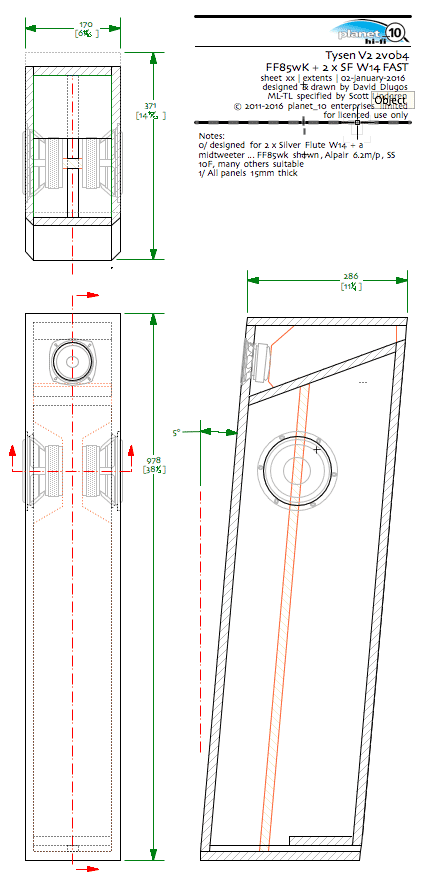

https://www.diyaudio.com/community/threads/alpair-7-3en-12pw-waw-build.319102/
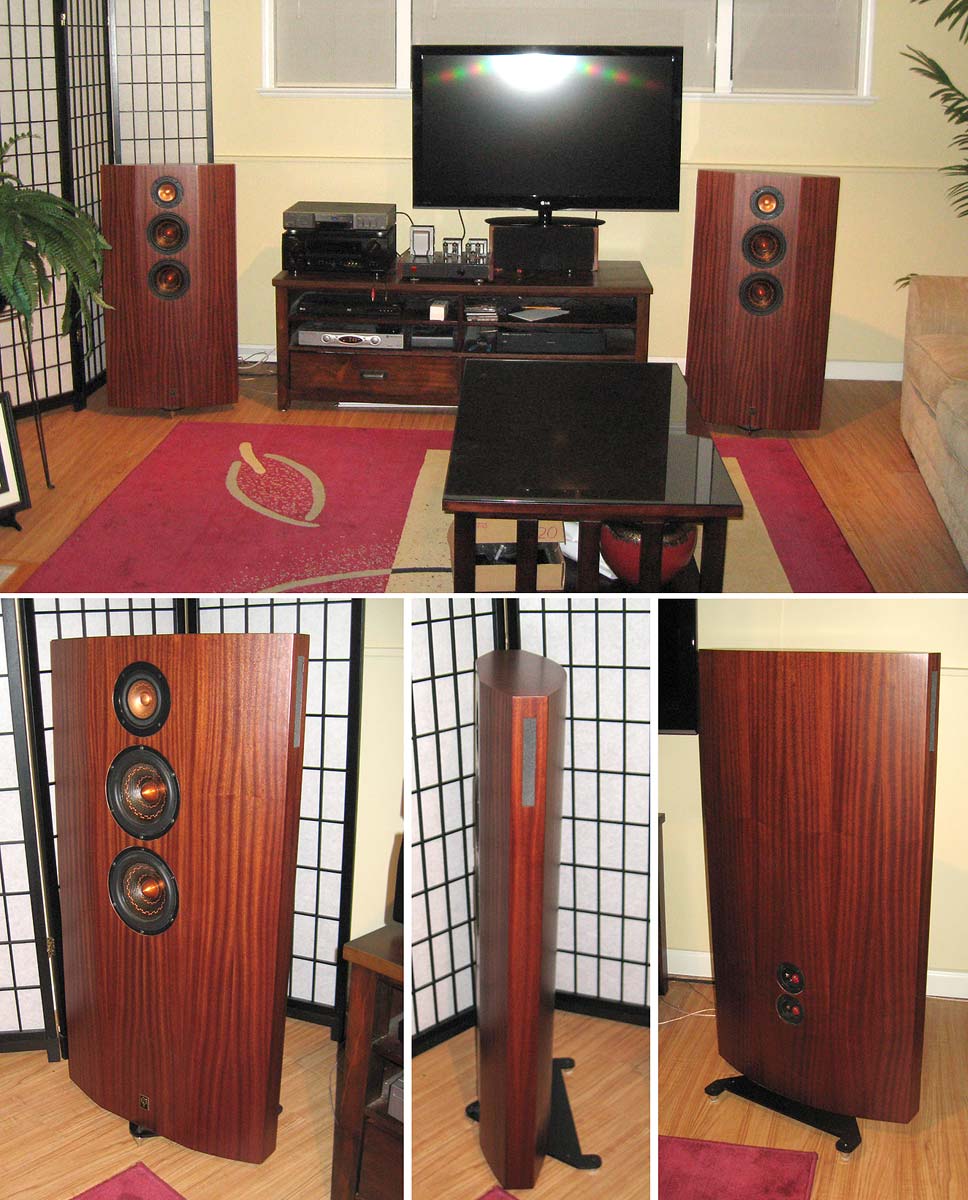
https://www.diyaudio.com/community/threads/p10-hifi-alpair-7-3en-sdx7en-waw-aka-fast.269393/
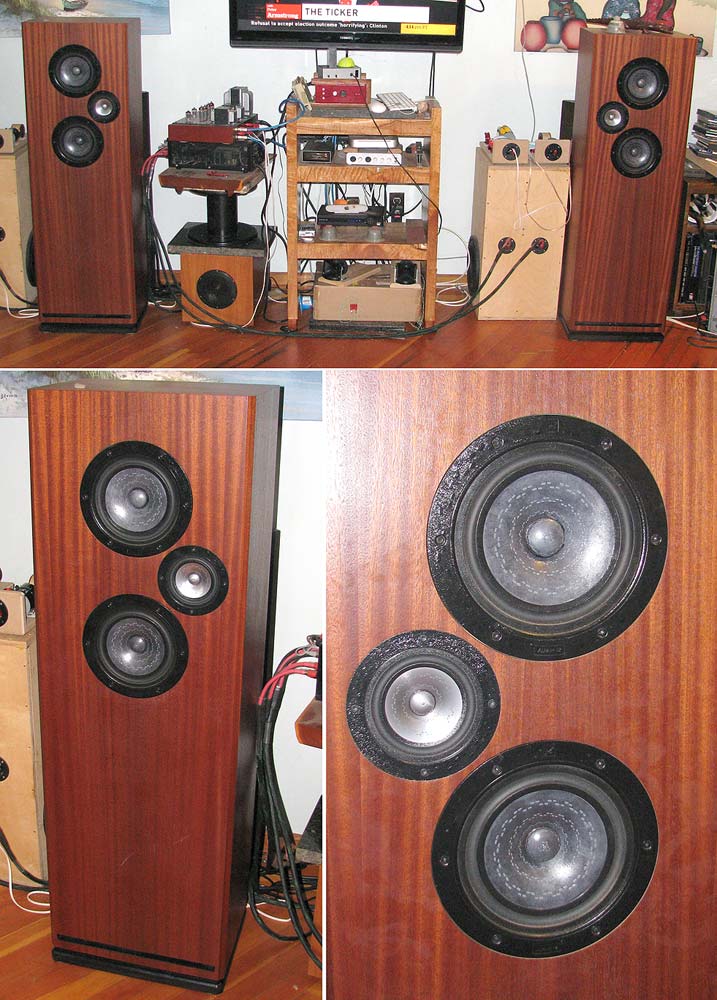
https://www.diyaudio.com/community/threads/alpair-12pw-7-3-12pw-mtm.367842/
dave
XOs are typically lower than 800hz (200-500 Hz). There is a huge amount of unexplored space.
We have done a number as examples (some examples):
I started this thread in 2009 to discuss these. https://www.diyaudio.com/community/threads/a-thread-for-tysen-and-variations-on-waw-fast.144099/


https://www.diyaudio.com/community/threads/alpair-7-3en-12pw-waw-build.319102/

https://www.diyaudio.com/community/threads/p10-hifi-alpair-7-3en-sdx7en-waw-aka-fast.269393/

https://www.diyaudio.com/community/threads/alpair-12pw-7-3-12pw-mtm.367842/
dave
Hmm, at a glance I don't see it doing 100 dB/m peaks cleanly down to 150 Hz, much less 106 dB/2m, ditto all the other 3" specs I browsed, though 'losing' 6 dB/octave going upwards, 300 Hz still seems marginal, so 5-600 Hz to have a bit of dynamic headroom.I have been thinking mark audio 3 inch on tube amp > 150 hz. Class D subwoofer < 150.
If your SPL goal is in stereo, then we 'gain' 3 dB, so 'pushing' it at 150 Hz and maybe 300 Hz is viable, but no 'hands on' experience with any of these large tweeters beyond what their 'Xmax, peak power' specs imply whereas the ones I suggested ensures they loaf along with plenty of dynamic headroom which was historically required for tube amps in general and especially if SET and 'tighter' polar response for when moving further than the ~ 1m nearfield.
Last edited:
I’d be taking the woofer a bit higher. 250-350 Hz. Unless it is near field or you don’t require levels as high as GM suggests.
dave
dave
Thank you, both. Yes a compression driver and horn could also work, and I suppose potentially better than a small full-range as it is closer to the CDs intended purpose. I've little experience of using them within DIY so wouldn't currently know where to begin, but another avenue for learning and research is fine (in fact good), as that is part of the fun and I'm only thinking ahead at this point.And in lies the significance….that 1” has excellent off axis response in the right horn and doesn’t start beaming until above 10khz…….fullrange/wide range are nice in the nearfield…….once you put some distance and need them to play loudly, the power compression becomes readily apparent within a few minutes and fatigue sets in……not so with the CD.
A little more....... the pioneers found that a 75 pc. orchestra's acoustic power mean was at ~500 Hz, so woofer <500 Hz and huge 1" throat compression horn for the rest that has withstood the test of time, so using a wide range for ~500 Hz up makes perfect sense from a acoustical power POV. Another is based on max speech intelligibility where the main BW is either 250-2500 Hz (AM band/6.5" frame), 300 - 3000 Hz (FM band/5 - 5.5" frame) to help you choose the best overall performing woofer, wide range for your app.
My reasoning to consider crossing around 800hz is because whilst I like small drivers for upper mid-range frequencies (IMO 3" is ideal from about 800hz), for larger/floorstanding speakers I definitely prefer >6" for lower midrange and upper-bass type frequencies. The 10" would be at their best up to a couple/few hundred herts, and I don't want to leap directly to a tiny cone driver in this multi-way project (though of course this can be done if one elects a different set of compromises and goes with WAW).
Crossing within the telephone band is also a compromise of course, but has some advantages that I find attractive: there is my preference for bigger drivers for lower-mid/upper-bass, the XO is low enough that driver spacing can be kept within my preferred distance, a mid-sized driver makes the transition between woofer and top-end more gradual and smoother, and the drivers need not handle more than (roughly) 2-octaves each. I think it was Dr Geddes who indicated that if one wants/needs to cross within the important band, do it below 1khz as our hearing is more forgiving of crossovers there.
But my thinking is based upon conventional cone drivers. I'm dimly aware of some benefits of horns etc, and a CD could certainly change some of that thinking; it might allow the compromises to be drawn differently. Whether they are what I want is something I now need to look into, so thank you very much indeed for the suggestion. I will probably have to start a new thread at some point; the mention of using a wide-range driver has led to people discussing other WAW projects in this one now.
Cheers,
Kev
Last edited:
Thanks, it is good to know that such things exist and are obtainable here. Though they seem quite spendy for a pair; nearly 4x the scanspeak 10f for example. Which doesn't preclude them, I'd just need to become sufficiently keen on them and take a while saving up.
Thanks, so they are on my 'to investigate' list, and so are compression drivers. I'll also revisit the alternative of using one driver across the telephone/radio band, to see if I can perceive those compromises in a better light.
Just to be clear, the tube amps and full-range-sat + sub arrangement mentioned above were not mine. I'm intending SS amps of whatever power is needed, and multi-way floor standers without subs. Though I appreciate that with some types of driver this might boil down to 2-ways of some kind, we shall have to see where it goes.
Just to be clear, the tube amps and full-range-sat + sub arrangement mentioned above were not mine. I'm intending SS amps of whatever power is needed, and multi-way floor standers without subs. Though I appreciate that with some types of driver this might boil down to 2-ways of some kind, we shall have to see where it goes.
- Home
- Loudspeakers
- Multi-Way
- Small Wide-Range instead of Small Midrange+Tweeter in Multi-Ways?
 .
.